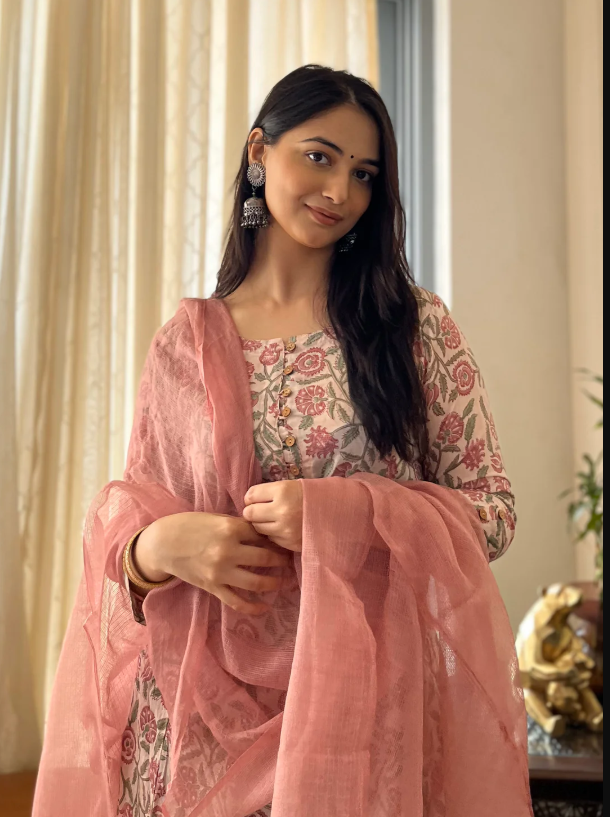
Categorizing the Elements of a Jaipuri Suit
A Jaipuri suit is not just another ethnic outfit; it is a representation of Rajasthani heritage, artistry, and craftsmanship. The uniqueness of these suits lies in their intricate prints, natural fabrics, and traditional dyeing techniques. To understand the beauty and significance of this attire, let’s break it down into its core components:
1. Fabric: The Soul of a Jaipuri Suit
The choice of fabric plays a crucial role in defining the appeal and comfort of a Jaipuri suit. Some of the most commonly used fabrics include:
Cotton: Highly breathable, perfect for everyday wear.
Chanderi: A lightweight fabric with a subtle sheen, great for semi-formal occasions.
Silk: Rich and luxurious, reserved for grand celebrations.
Mulmul: Soft and delicate, known for its airy feel.
Georgette & Crepe: Contemporary adaptations that bring fluidity to traditional designs.
2. Prints and Patterns: The Identity of a Jaipuri Suit
Jaipur is renowned for its centuries-old block printing techniques, which make a Jaipuri suit instantly recognizable. The most popular patterns include:
Bagru Print: A traditional block printing method using vegetable dyes, creating floral and geometric motifs.
Sanganeri Print: Delicate floral designs with intricate detailing, often seen on lighter fabrics.
Dabu Print: A resist-dyeing technique that creates deep, earthy patterns.
Leheriya & Bandhani: Tie-dye techniques that result in vibrant wave-like and dotted patterns.
Each print tells a story, reflecting the artistic heritage of Rajasthan while keeping ethnic fashion relevant.
3. Color Palette: Inspired by the Land of Royals
The vibrant hues of a Jaipuri suit are inspired by Rajasthan’s landscapes and culture. The most commonly seen colors include:
Bright Yellows & Oranges: Reflecting the warmth of the desert sun.
Deep Blues & Turquoises: Inspired by the traditional indigo dyeing methods.
Royal Reds & Pinks: Symbolizing festivity and celebration.
Earthy Greens & Browns: Representing nature and sustainability.
Natural dyes are often used in Jaipuri prints, ensuring that the colors remain rich yet eco-friendly.
Adapting the Jaipuri Suit for Different Occasions
The versatility of a Jaipuri suit makes it suitable for various events. Depending on how it is styled, it can transition from casual wear to festive attire effortlessly.
1. Daily Wear & Work Attire
A lightweight cotton Jaipuri suit with minimal embroidery works well for everyday wear.
Straight-cut pants or palazzos paired with a printed kurta offer comfort and sophistication.
Neutral-colored juttis and oxidized earrings complete the look.
2. Festive & Wedding Wear
A silk or Chanderi Jaipuri suit with gold or silver block prints adds a regal touch.
Dupattas with gota patti or mirror work elevate the elegance.
Heavy jhumkas and embroidered juttis bring the ensemble together.
3. Contemporary Styling for Fusion Wear
A flared Jaipuri suit with a modern jacket overlay makes for an Indo-western look.
High-low hemlines and slit kurtas bring a contemporary edge to traditional prints.
Sneakers or heeled boots can be paired for an unconventional twist.
Regional and Cultural Significance of Jaipuri Suits
The Jaipuri suit is more than just an ethnic outfit—it holds cultural significance. Many artisans in Rajasthan continue to use traditional hand-block printing techniques, sustaining an art form passed down through generations. The craftsmanship involved ensures that each piece is unique, making it a symbol of slow fashion and sustainability.
Additionally, in Rajasthan, specific prints and colors are associated with festivals, marital status, and even seasonal preferences. For example, red and yellow suits are popular during Teej and Gangaur, while indigo prints dominate summer collections due to their cooling properties.
Caring for a Jaipuri Suit: Preserving the Artistry
Since most Jaipuri suits are made using delicate fabrics and natural dyes, proper care is essential to maintain their beauty:
Hand wash in cold water: Helps preserve the color and prevent fading.
Use mild detergents: Harsh chemicals can damage the prints.
Avoid direct sunlight while drying: Ensures that colors remain vibrant for a longer period.
Iron on low heat: Protects the intricate fabric from damage.
By following these simple care tips, a Jaipuri suit can last for years without losing its charm.
Why the Jaipuri Suit Stands Out in Ethnic Fashion
Authenticity: Unlike mass-produced garments, a Jaipuri suit carries the essence of handwork and traditional craftsmanship.
Sustainability: Many artisans use eco-friendly dyes and ethical practices, making it a responsible fashion choice.
Timelessness: Trends may come and go, but the elegance of a Jaipuri suit remains constant.
Comfort & Versatility: From hot summers to breezy winters (with the right layering), it adapts effortlessly to different climates.
Heritage & Modernity: It bridges the gap between classic Indian textiles and contemporary fashion needs.
Final Thoughts
A Jaipuri suit is more than just a garment; it is a piece of history woven into fabric. Its prints, colors, and craftsmanship make it a cherished addition to any wardrobe. Whether worn casually or styled for a grand occasion, it never fails to capture the richness of Rajasthan’s textile heritage. Investing in one is not just about fashion—it’s about owning a slice of tradition that continues to thrive in modern times.





















Write a comment ...